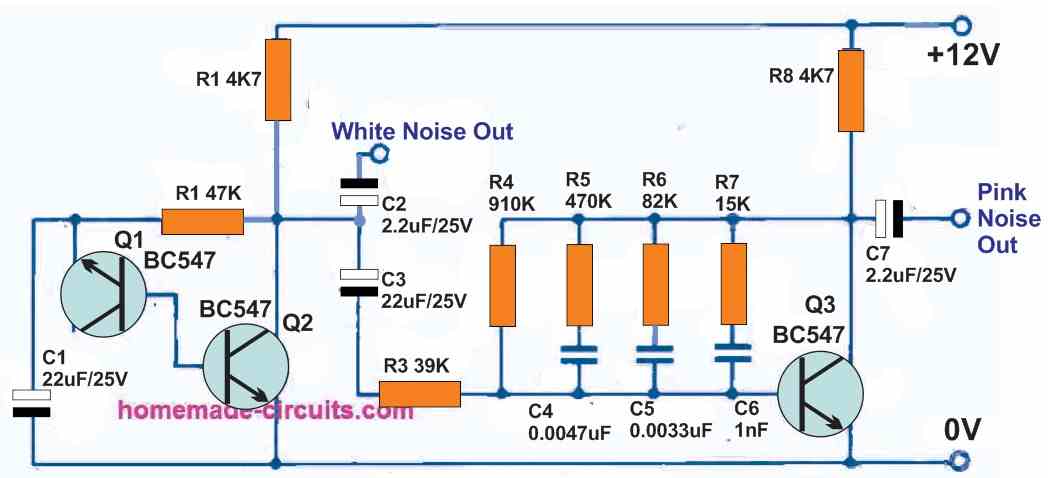The construction of a basic circuit for a white noise generator that may be filtered to produce pink noise is covered in this post.
You are going to find that the white or pink noise is precisely the same as the noise we receive on FM radios when there is no radio station present or on TV sets which just display raster when there is no signal.
The following article has additional details regarding pink noise:

Understanding the Meaning of RF Noise
Generally speaking, noise is an undesirable component that can reduce any measuring device's effectiveness. Therefore, it could seem strange that any user would need to create such a noise, but to you, this might seem perfectly natural.
In order to figure out the low signal performance of radio-frequency amplifiers, noise generators are commonly used to induce noise into the amplifiers.
Similar to a random signal generator, noise production is also found to be helpful for testing sound systems and adding wind-like sound effects to musical outputs. 'White noise' and 'pink noise' are two often utilized noise generator qualities.
What is White Noise
The reason white noise gets its name comes from the fact it has the same noise level over the whole frequency range across comparable bandwidths. As a result, for example, a white noise source may have the same energy in the 100–200 Hz and 5000–5100 Hz frequency regions.
The term "colored noise," or even more specifically "pink" or "grey" noise, is used to describe the white noise that has undergone a filtration or modifying procedure.
What is Pink Noise
Pink noise is typically defined as the noise characteristic that contains the same amount of energy for every % shift in bandwidth. When a real pink noise is taken into account, for example, the energy between 100 Hz and 200 Hz has to be the same as that throughout 5000 Hz and 10,000 Hz (a 100% change in each case).
A higher degree of bass frequency appears to be present in pink noise as opposed to white noise.
In the course of the testing procedure, listening the pink noise may seem much more constant and persistent.
It must undergo a filtering procedure to change white noise to pink noise, typically lowers its output intensity by 3 dB per octave or 10 dB per decade when the frequency is enhanced.
How the Circuit Works

The transistor Q1 is actually demonstrated in the design for the pink noise generator above set up as a zener diode. It is possible to observe reverse-biased base-emitter junction wiring, which enters a zener breakdown condition at around 7 to 8 volts.
White noise of around 150 millivolts is produced at the output when the Q1 zener noise current flows to the Q2 base.
In addition to functioning as a noise source, this "zener" design efficiently biases Q2, and the output of the Q2 noise is directly applied to the White Noise output.
It was necessary to go through a filtering procedure that reduces the frequency by 3 dB every octave in order to convert the white noise to pink.
To achieve a reduction of 6 dB per octave, a standard RC network might not be suitable for implementation, such as an individual RC stage. To approximate the desired 3 dB-per-octave slope, a special resistor Rs and capacitor Cs circuitry is therefore required.
An amplifier becomes required to restore the output level since this type of filter can provide a significant amount of noise suppression.
The pink noise filter is connected as a feedback network between the collector and base of the transistor Q3, which is designed similarly to an amplifier for this purpose.
By controlling the transistor's gain-versus-frequency features, you may get the required quality. By doing this, we can obtain the necessary pink noise from transistor Q3's output, and this is subsequently fed into the circuit's designated output socket.
A Single BJT Circuit
One transistor and a Zener diode might be used to create a basic white and pink noise generator. In addition to stabilizing the transistor's functioning level, the 10 volt Zener acts as a noise generator.

To change the output from "white" to "pink" noise, place a capacitor C2 at the designated location. The supply input and the designated elements are going to result in an output voltage with a white noise level of around 15 V and a pink noise level of about 14.5 V. The BC547 or any other comparable tiny signal transistor can also function well.
Leave a Reply